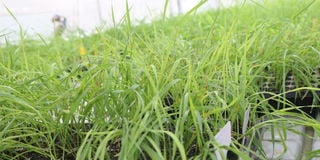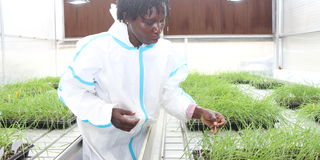Good news for wheat farmers

Wheat samples at the ultra-modern, state-of-the-art rust screening facility at Njoro sub-county on April 5, 2025.
The Kenya Agriculture and Livestock Research Organisation (KALRO), in collaboration with the International Maize and Wheat Improvement Center (CIMMYT), has launched a state-of-the-art rust screening facility in Njoro sub-county.
Rust is a fungal disease that mainly affects wheat and consists of three main types - leaf rust (commonly known as brown or orange rust), stripe rust (also known as yellow rust) and stem rust (also known as black rust).
Dr James Karanja, director of the KALRO centre, explains that the facility uses advanced technology to mimic the exact conditions that wheat crops face in the field.

Dr James Karanja, KALRO Center Director, during the launch of the ultra-modern, state-of-the-art rust screening facility at Njoro sub-county on April 5, 2025.
The aim is to speed up the development of new wheat varieties resistant to rust.
"Traditionally, developing resistant wheat varieties has been a lengthy process, taking seven to eight years. This new facility is one of the ways we can develop new varieties and reduce that time frame to just four to five years," Dr Karanja explains.
Rust starts on the wheat leaves and can spread to the stem and head. The disease can cause significant yield losses, sometimes wiping out entire crops. It also increases production costs for farmers.
"One of the biggest challenges we've faced in our research is that farmers are successfully growing their crops, but just as they're about to mature, the disease strikes. With this facility, we can now replicate the ideal conditions for the disease to develop. This allows us to detect symptoms much earlier, within four weeks, rather than waiting two or three months. We can quickly identify which crops are susceptible," says Dr Karanja.
"Unfortunately, rust starts from the leaves and goes to the stem and you know that once the leaves, the plant's kitchen, and the stem (the food distribution channel) are affected, it means the plant will not be able to feed well and that means the plant is likely to die," he notes.

Dr Zennah Kosgei, a plant pathologist at KALRO, inspects some of the wheat samples at the ultra-modern, state-of-the-art rust screening facility at Njoro sub-county on April 5, 2025.
Dr Zennah Kosgei, the facility's plant pathologist, explains that some characteristics of stem rust include small to medium-sized orange pustules on the stem.
On the leaves, the pustules may not be as large as those on the stem, but they often appear in clusters on both the upper and lower surfaces of the leaf.
In addition to rust, other emerging diseases they are currently looking out for include spot blotch and fusarium head blight (which affects the heads of wheat), which is being exacerbated by climate change.
Nakuru County, where the facility is located, produces about 450,000 tonnes of wheat annually on 12,500 hectares.
It is the second largest wheat-producing county in the country, with farmers from Njoro, Rongai, Molo, Bahati and parts of Kuresoi North and Naivasha growing the crop.


